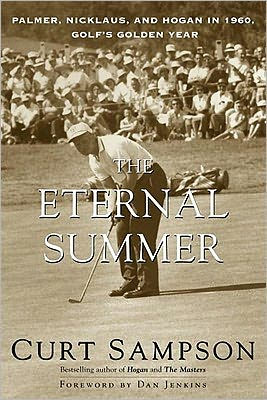Read an Excerpt
The older a golf writer gets, the more he lives in the past. This may be true of real people, too. I can only speak for golf writers. Youth is in the past, for one thing, and golf writing may have been a hobby as much as a profession, based on the salaries most of us made.
There have been many splendid, important, landmark years in golf, and 1960 goes in there with four other years that come to mind immediately. There was 1913, when Francis Ouimet did that thing to Harry Vardon and Ted Ray. There was 1930, when Bobby Jones did that thing with the Grand Slam. There was 1945, when Byron Nelson did that thing with eleven in a row. And there was 1953, when Ben Hogan did that thing with the Triple Crown.
A lot of things put 1960 in there, things that Curt Sampson will tell you about in more detail, but mainly I will always remember it as the year Arnold Palmer became the Arnie of "Whoo, ha, go get 'em, Arnie!"
It was the year that Palmer, sweating, chain-smoking, driving balls through tree trunks, shirttail flying, took golf to the masses.
It was the year Arnie's Army was born, a horde of happy street rabble that would later encourage enlistments into Nicklaus's Navy, Lee's Fleas, Ben's Wrens (as in Crenshaw), and Greg's Groupies.
It started happening at the Masters in '60, when Arnie birdied the last two holes to win, and then he was truly ordained as America's golfing darling at the U.S. Open in June.
Thanks to the expense account departments at the Fort Worth Press, the Dallas Times Herald, Sports Illustrated, and Golf Digest, in order of their appearance in my life, I'm quite sure I've covered more majors than any golf writer, living or dead. Something like seventy of them to date. And I'm certain I've never seen a more thrilling tournament than the 1960 U.S. Open at Cherry Hills in Denver.
Three eras came together on the final day, or "Open Saturday," as it was known. The day embraced the last hurrah of Hogan, the confirmation of Palmer, and the preview of a burly Ohio State undergraduate with terrifying length and frightening powers of concentration--Jack W. Nicklaus.
It's a pleasure to recall that I was an up-close witness to all of the drama that day, but 1960 had other remarkable theater, subplots, undercurrents, and characters that would help change the game as we know it.
History is only as interesting as the historian makes it, and here I must congratulate Curt Sampson on his passion for the game as well as his skill with a pen. And, while I may not agree with every characterization or interpretation in The Eternal Summer, at least the author comes by his prejudices honestly.
Sampson was the golf course equivalent of a gym rat as a kid--caddie, shop assistant, greens mower, and gofer. He played hooky regularly to watch the CBS Golf Classic, which was taped at Firestone Country Club every fall in the late sixties. Inspired by all this proximity to golf pros, he became a minor league touring professional himself, though his name was hard to find among the money winners.
He then sold widgets for ten years before returning to golf as a writer, and made the unhappy discovery that widget salesmen play more golf than golf writers do.
The Eternal Summer will make you feel like you are there at Augusta, Cherry Hills, St. Andrews, and many other places.
I know. I was there. In some ways, I'm still there.



